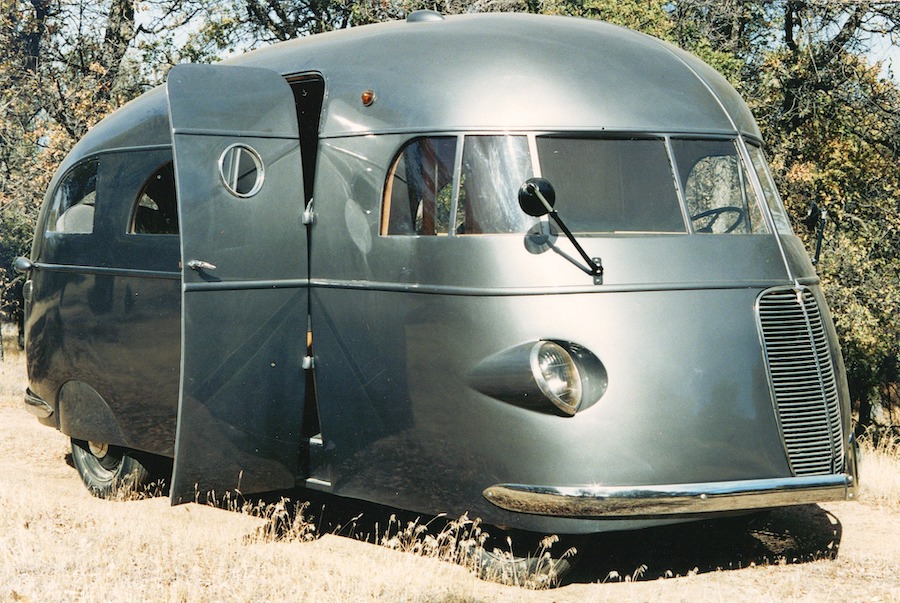Thanks for your support! If you make a purchase using our links in this article, we may make a commission. And, as an Amazon Associate, I earn from qualifying purchases. See the full disclosure here.
If you complete a quick online search on RV history, you’ll see fascinating travel trailers and motorhomes that date back over 100 years. While each of them contributed to the industry, it’s challenging to find a complete history of RVs and campers that focuses on the significant influencers that led to our generation’s coaches.
We’ll point out the motorhomes, travel trailers, and industry-altering components that have contributed the most to the industry over the years. Their design and foundational innovation live on through the various brands you see on the road today. You’ll also learn about the era that defined them and the people behind the scenes.
As your tour guide, we ask that you please refrain from touching the RV artifacts. We also ask that you don’t use flash photography. Finally, if you are lucky enough to own one of these mobile pieces of history, please share some pictures so we can admire them with you.
Ancestral History of the RV
The concept of a “home on wheels” isn’t a new one. It was perfected by the Romanichal (or Romany) culture in the 16th century. This nomadic eastern European people, known by the term “Gypsy” (please note, this term is considered derogatory among their culture), traveled the continent living within or around their horse-drawn covered wagons.
Two centuries later, during the American Western Expansion, people would travel in caravans or alone in their covered wagons to find a piece of land to start a new life. The western settlers usually slept outside of their wagons, but some did rest inside in times of illness.
The Antique RV Era (1910- 1945)
Henry Ford was not the inventor of the automobile. He invented the assembly line, making cars affordable to the average worker (Richard Trevithick built the steam-powered horseless carriage in the UK in 1803). It didn’t take long for people to start playing with the design to make something more out of Ford’s Model T.
The Antique Era produced epic advancements in travel trailers. People would hitch up the trailer that led to today’s pop-up campers and do-it-yourself teardrops to their Model T cars to vacation at the newly made U.S. National Parks. Others would create homemade Class A motorhomes on bus chassis. RV features came out of necessity or from other vehicle sectors.
1910 Pierce-Arrow Touring Landau
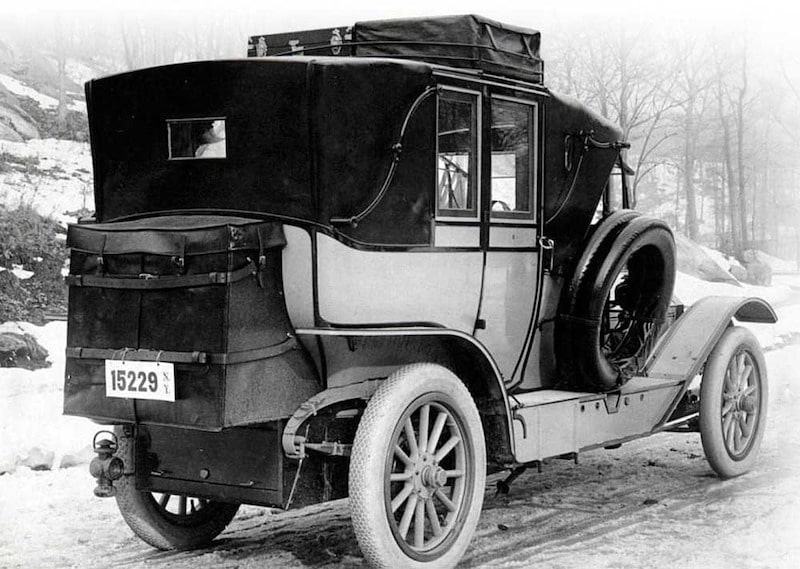
At the 1910 World’s Fair, the public saw the Pierce-Arrow Touring Landau for the first time. It had a folding sink attached behind the driver’s seat, a rear fold-down seat that turned into a bed, a telephone to communicate with the driver, and a chamber pot for a bathroom.
The Landau was a touring car made for the wealthy to ride around the city streets. It competed against passenger vehicles like Packard and Peerless through the 1930s. While this touring car wasn’t an RV, it introduced features that would show up in the RV industry shortly.
1915 Conklin Gypsy Van
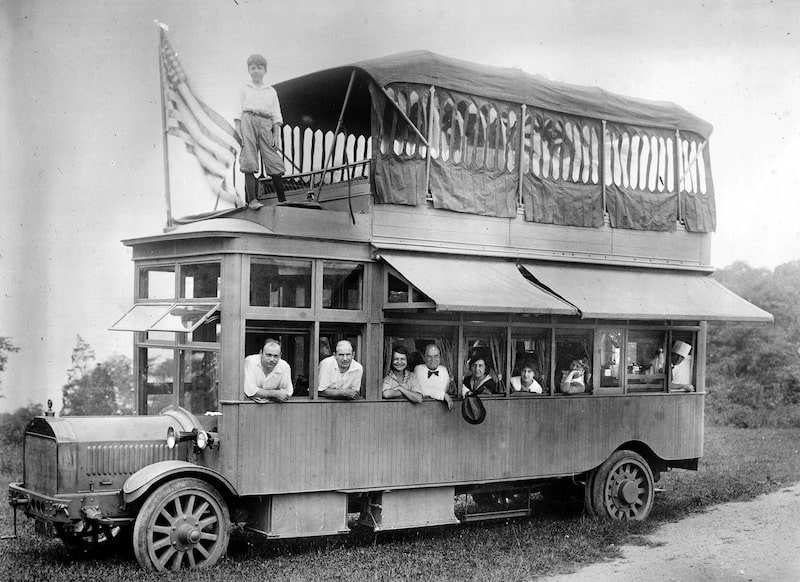
Another influential RV of the time was the 1915 Conklin “Gypsy Van.” This 8 ton Class A motorhome existed on a bus chassis. It had both a gas engine and an electric generator. There was even a garden on the roof. The double-decker came with a shower and commode, folding tables, folding padded sofas to sleep on, and some other creature comforts.
The RV measured 21 feet long by 7.5 feet wide. The main level had 6.5-foot high ceilings. Conklin’s success in personal wealth and construction came from his ownership of his bus and taxi companies.
Roland and Mary Conklin packed up their family (with three hired employees) and started the cross-country adventure from Huntington, NY, to San Francisco, CA. The New York Times was the first newspaper to cover their journey. In every town they passed through, the local paper would report their progress.
Tent Campers
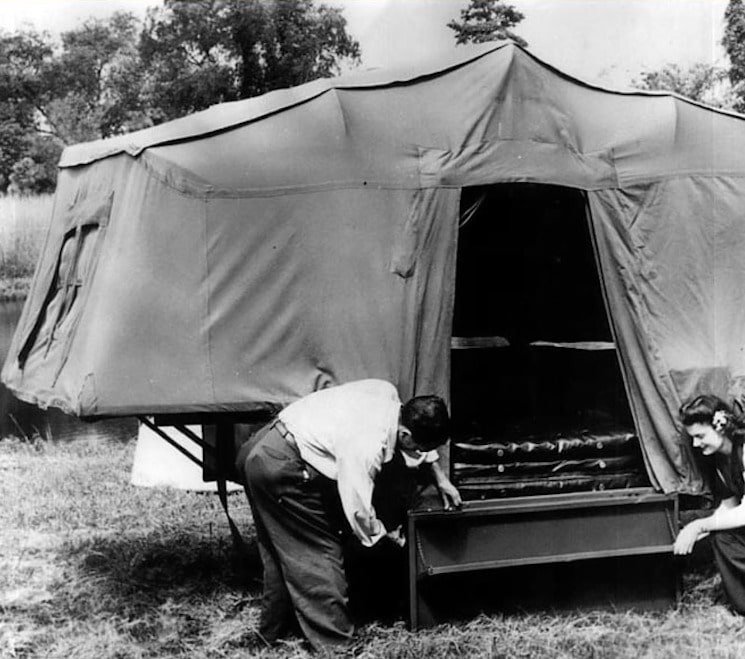
Initially, during the 1910s and 1920s, people would hop on a train to see Old Faithful or the Grand Canyon. As camping became popular, families would set up family-sized canvas tents that were floorless. Now that cars were available, people would hitch up travel trailers that fit nicely in the national park campgrounds.
The first were tent campers made by manufacturers or constructed from published blueprints in popular magazines. Tent campers were canvas shelters that used aluminum poles that fit into trailer chassis and sidewalls. Campers would use the lanterns and stoves from W.C. Coleman’s company or others to enhance the camping experience.
The Original Teardrop Sleeper Trailers

By the late 1920s, magazines like Popular Mechanics, Popular Science, and Mechanix Illustrated published D.I.Y. blueprints of teardrop trailers people had designed themselves. Materials included wood or aluminum. After World War II, veterans would continue to publish and build them using surplus military parts. One of those designers, Wally Byam, would create an RV legacy like no other.
1930 Sherman Covered Wagon
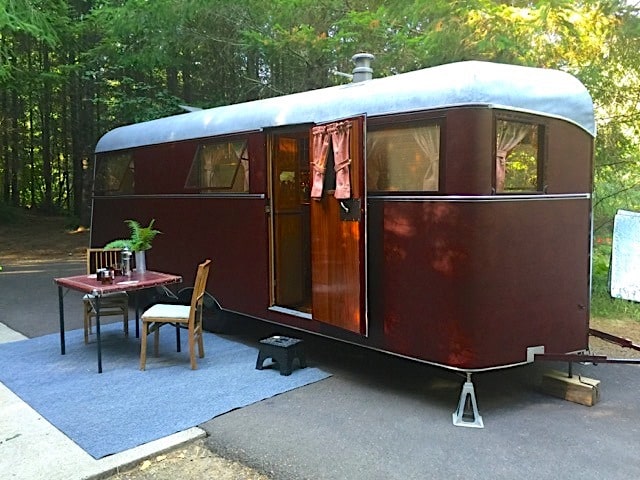
Scientist Arthur Sherman of Detroit, Michigan, decided to take his family on a camping vacation in upper Michigan (those unfamiliar with Michigan terminology, the northern part of the lower peninsula). The family had a horrible weekend due to the torrential rain. When they returned home, Sherman headed to his garage. Employing a carpenter, he designed a self-contained travel trailer that didn’t require any setup.
Using a combination of metal, leather, and other materials, he featured his Covered Wagon travel trailer at the 1930 Detroit Auto Show. It slept four, had a kitchen, and window shades to keep the weather out. It was an instant hit, much to the dismay of the actual vehicle manufacturers at the show.
The factory established itself in Mount Clemons, Michigan. Even during the Depression, orders still came in. Once WWII ended, the board of directors chose to sell the company rather than start back up. His concept of a self-contained travel trailer became the foundation of every travel trailer design of the future.
1930 Curtiss Aerocar Land Yacht
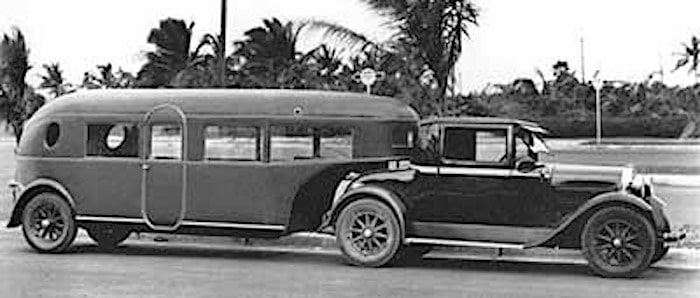
In the 1850s, blacksmiths discovered a new hitch for horse-drawn wagons that helped loggers and other heavy-haul industries. They called it a fifth wheel hitch because it acted like another wheel on the wagon. It allowed the drivers to maneuver rougher terrain and make tighter turns without having to unhitch the horses. The hitch also allowed for horizontal shifting at the top and bottom of hills.
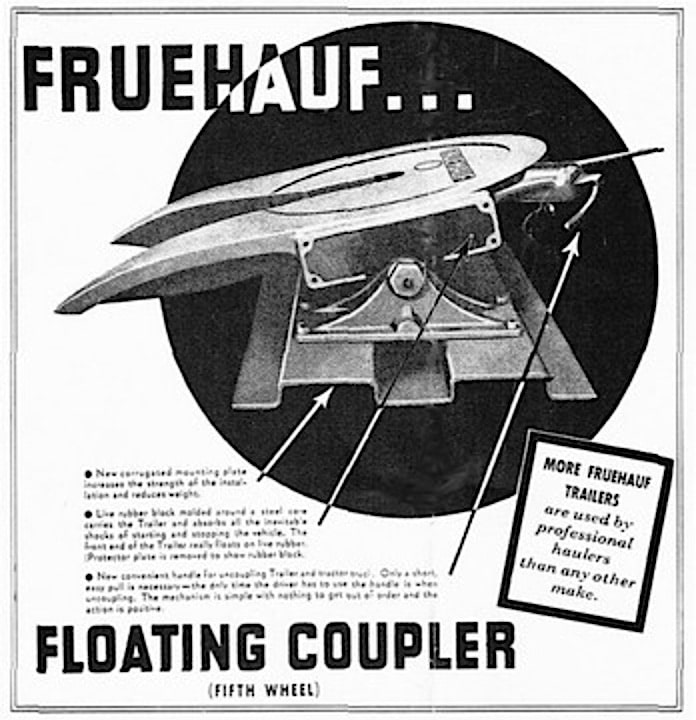
In 1914, the Freuhauf company patented their floating fifth wheel hitch giving early commercial trucks the ability to haul heavy loads. Today’s fifth wheel and long-haul semi-trucks use an evolved version today.
For more refined tastes, Glenn Curtiss, an aircraft engineer, designed his fifth-wheel Aerocar travel trailer. The leather and velvet interior was the pinnacle of style that came with a starting price tag of $2,500 during the Great Depression. Buyers could choose between the specially designed coupe or roadster to pull the Land Yacht.
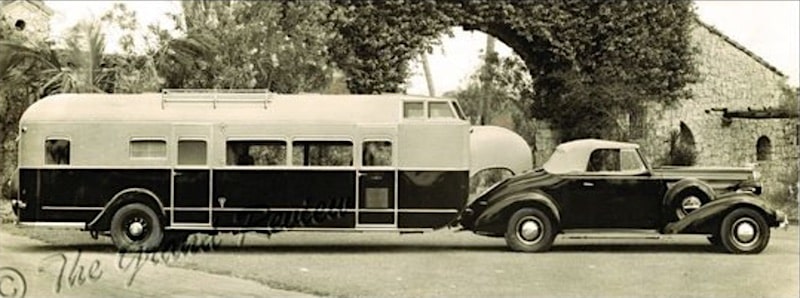
While the Land Yacht is considered the first 5th wheel, the pneumatic hitch connected to the car used a flat rubber washer in a steel box, nothing like a kingpin hitch today. The hitch did give the trailer a six-way rotation for road conditions, but you couldn’t use the hitch for anything else.
1940 GM Futurliner
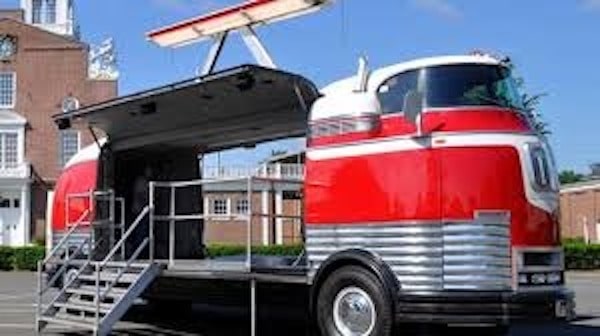
For the 1940 World’s Fair, GM created 12 art deco locomotive-looking vehicles for their “Parade of Progress.” The sides would open up as a display to highlight anything from jet engines, radios, or TVs until 1956. Today of the 12, two are lost, two are beyond repair, one is in Europe, and only two occasionally show up at RV shows. If you get a chance to see one up close, don’t expect to go inside, but the owners display pictures of the restored interior.
The ones that still have the side display only have the central driver’s area and two seats behind. These vehicles were only mobile display cases; the engineering and design were inspirational for the RV world. It showed future Class A motorhome engineers the possibilities of what a motorcoach could be.
The RV and Camper Vintage Era (1948- 1970)
During the Great Depression, many RV companies shut their doors. Those that survived converted their assembly lines to do their part for the war effort. Some would stay in the RV business, building travel trailers to use for additional base housing.
Small RV builders that closed their doors would find work where they could during the depression. Those lucky enough to continue working in the field would lend their talents to surviving companies. Wally Byam spent these years with Curtis Wright Industries, improving the designs of the Aerocar Land Yacht.
When the boys returned home from war, they became family men who wanted to go camping. Families wanted RVs with home-like features with minimal setup. They wanted a comfortable camping experience versus “roughing it” in a tent.
The 1950s “Canned Ham” Travel Trailers

Companies like Shasta and others offered travel trailers that resembled the shape of processed meat cans. The “Canned Ham” period of travel trailers had permanent beds for parents, fold-down dinettes, furniture for kids to sleep on, kitchen appliances, and cabinetry. Exterior color schemes were as bright and bold as the cars that pulled them.
The vintage era travel trailers gave the RV world self-contained coaches that had features people could sustain themselves in for days at a time before they had to restock supplies. Many of the amenities we see today started in this period.
1963 Dodge Travco

In 1963, Raymond Frank changed the entire dynamic of Class A RVs. Previously, all drivable RVs were custom built. Frank Manufacturing Company changed all of that with the Dodge Travco. The motorhome used a Dodge chassis and a Chrysler V8 with a 318 hp engine. As the years continued (until the late 1980s), the boxiness shaved down to curved edges.
1966 Winnebago Brave
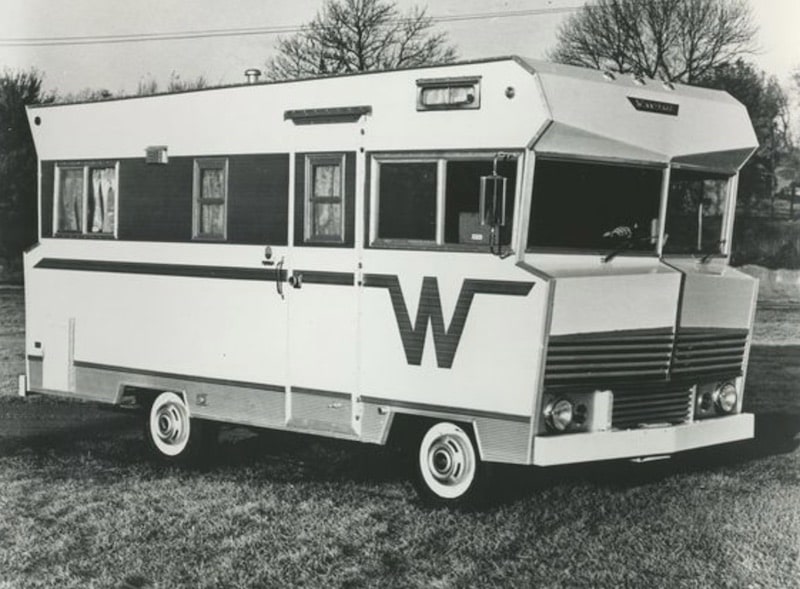
Ray Frank couldn’t rest easy for too long because a California RV furniture company that moved to Iowa in 1965 would give him a run for his money. In 1966 Winnebago introduced the Brave. The Brave continually outsold the Travco and the other competition that would eventually join in due to its low cost and many features.
Winnebago’s became the Ford Motor Company of the RV industry. Developing an assembly line method for their products allowed them to become an industry giant quickly. Their RVs appealed to most RV consumers, were affordable, and had national distribution.
Why Do We Keep Mentioning Wally Byam?
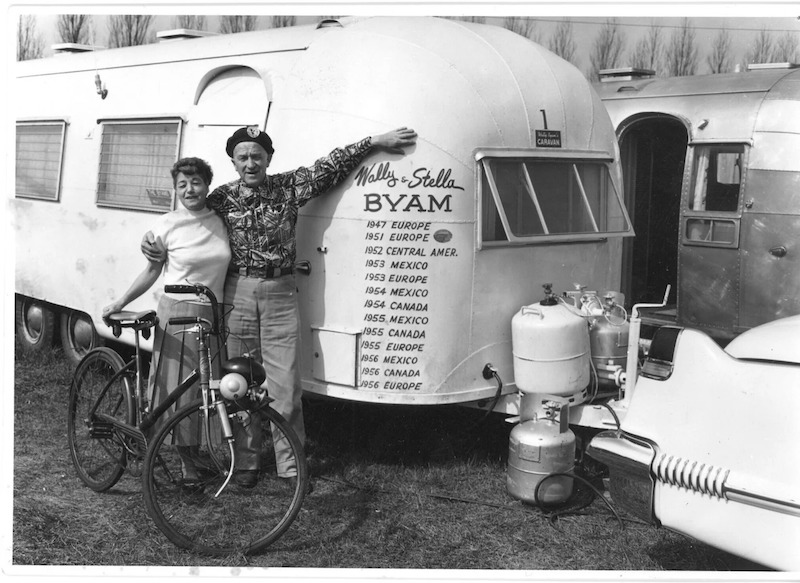
If you don’t know his name, you know his brand. His products have the most movie and TV credits of any RV in Hollywood. His iconic “Silver Bullet” travel trailers follow the same construction methods he created since he re-opened his doors in 1947. His company is the oldest RV manufacturer still in operation. That company’s name is Airstream.
Byam and Airstream’s contribution to The Complete History of RVs, and Campers is timeless. While the average RV has a lifespan of 20 years, over 75% of all Airstream travel trailers are still on the road. The individual efforts Airstream has made to RVs are too numerous to list.
The RV History Classic Era (1971- 1989)
The Classic Era is the time where RV companies gained the most prominent audience it had ever seen. Baby boomers were now raising their families and the “Greatest Generation” started discovering the merits of full-time RVing. Camping clubs developed, and private campgrounds were on the rise.
RV companies were still in the experimental phase when it came to figuring out how to balance the creative process and managing good business practices. An auto industry giant would dabble in the RV realm for a bit and make a decision some consider questionable.
1968 Revcon and 1973 GM Motorhome

In 1968, John Hall, the son-in-law of Wally Byam, branched out to create his own Class A motorhome. It started as a four-wheeled vehicle, but he added a double-axle in the rear for an added load advantage after a few years. He partnered with GM using their 1966 Oldsmobile Toronado chassis and their Chevrolet V8 454 hp engine.
It had a permanent queen-size bed, full kitchen amenities, a living room with a sofa, and a raised driver’s area. The front-wheel-drive Class A had a low profile to give it a smooth ride down the road. The front end started flat, but as the years progressed, Hall gave it a pointed front end giving it an aerodynamic shape, famous for the period.
GM tested the chassis for their cars but didn’t have much data regarding RVs or trucks. GM made Hall perform all of the testing to ensure it would hold up for RV demands at his own expense. Once GM was satisfied, the auto-maker became Hall’s competitor.
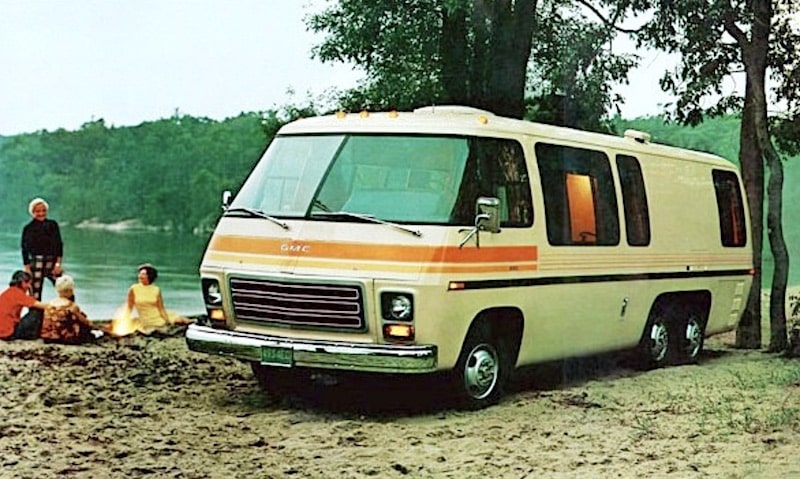
From 1973-1978, GMC built their motorhome. The curved sidewalls gave it the nickname the “GM Submarine.” They produced it in limited quantities each year, not expecting a lot of sales. The 23-foot version had a price tag of $13,569.06, and the 26-footer started at $14,569.06. Instead of fiberglass, they used aluminum for the sidewalls.
While in production, 12,921 sold throughout the United States. Today, estimates conclude that there are around 9,000 still on the road. There are many factors GM had to consider when they decided to discontinue the RV:
- The late 1970s gas crisis
- The discontinuation of the chassis and engine
- Low profit-margin
- Other mitigating factors
Many speculate it boiled down to a financial concern or GM not seeing a future for the RV industry. If you’re reading this in your travel trailer or motorhome, try not to laugh too hard.
Truck Campers and Toyota’s New RV Category
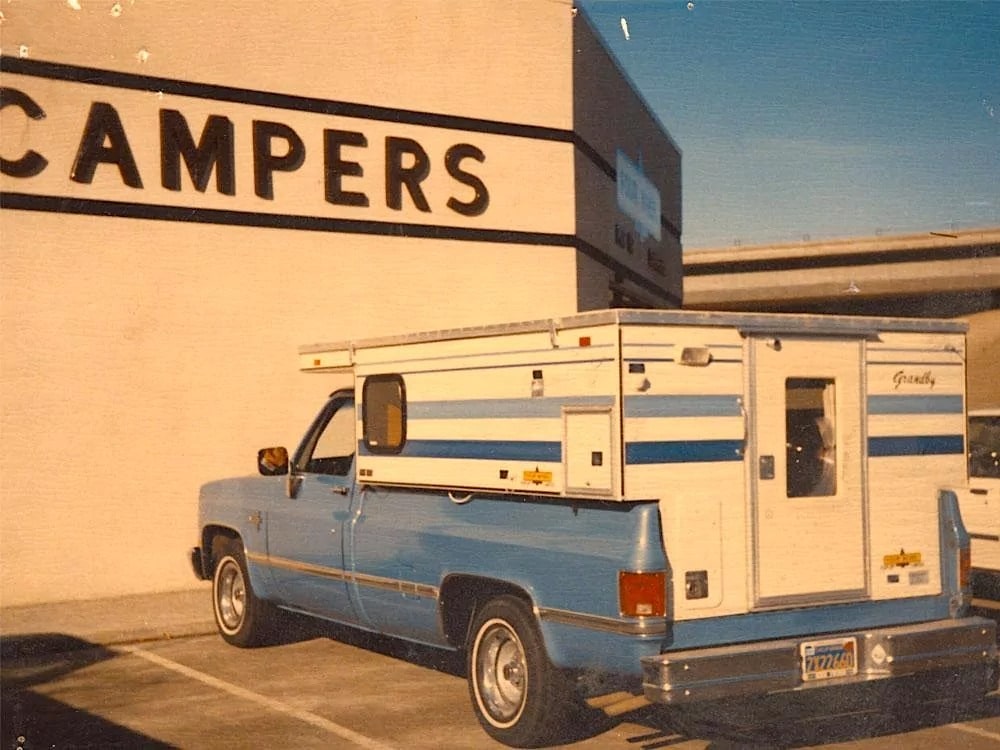
Truck campers have their origin in the 1920s. The concept of a compact camper that fits into a pickup truck’s bed made camping a possibility in rougher terrains. In 1972, David Rowe created a lift system that expanded the top of truck campers. The soft-shell folding top sidewall allowed for more headspace while camping and made the camper more aerodynamic while traveling.
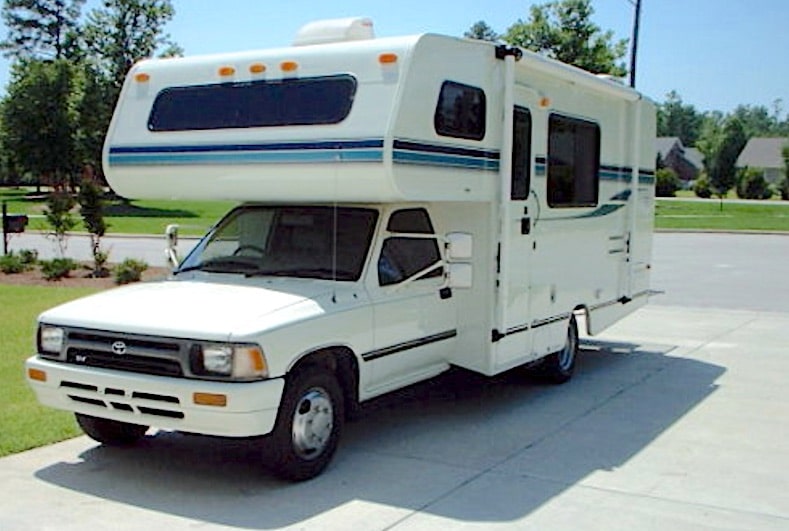
Meanwhile, in the early to mid-1970s, a Japanese auto-maker named Toyota was still finding its footing in the American automobile market. They had a quarter-ton truck with excellent fuel economy that came as a 4-cylinder with an optional V6. When RVs were getting bigger, they decided to attach a truck camper-type coach to their truck permanently.
Toyota called their Hilux RV a micro mini-motorhome. Its size was ideal for two people. It had a bed above the driver’s area, a rear bathroom, mid-coach kitchen, two-seater dinette, and a comfortable rocking chair behind the co-pilot’s seat. Toyota didn’t make many sales on the motorcoach, but it introduced the American market to the possibility of the Class C motorhome concept.
Today, there is a fan-base, and a significant portion are still on the road. If someone asks you which came first in the Class C category, the van or the pickup chassis, now you know the answer.
Why are Campervans Called Class B?
The Class B motorhome did come before the Class C, but not here in the United States. For that answer, we’re going to have to take a trip across “the pond” to Germany. Shortly after World War II, Volkswagon introduced their Type 2 Combi Bus. A third-party vendor, Westfalia, offered a campervan conversion that started the original #VanLife in Europe.
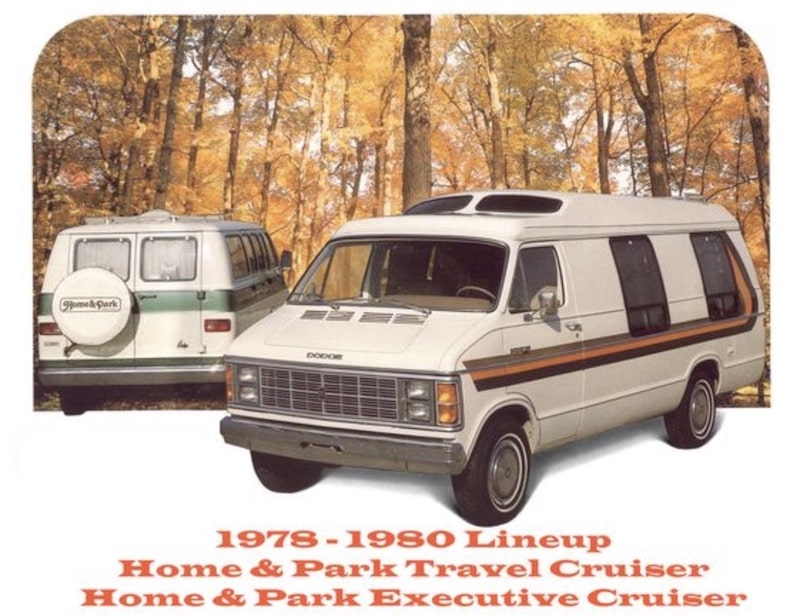
The North American beginnings of Class B motorhomes started in the 1970s. Jac Hanemaayer built his first van-styled motorhome while working for Home and Park Vehicles Limited in 1974. Eventually, he would buy the company and change the name to Roadtrek. His goal was to offer all of the comforts of Class A motorhomes in an easy-to-drive van.
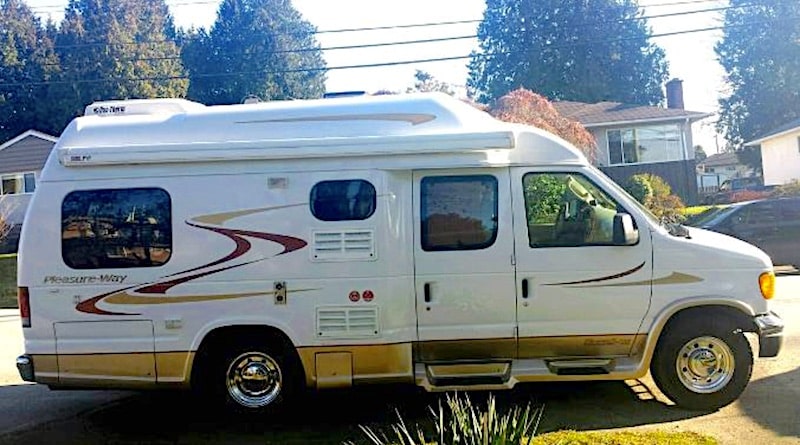
Four years later, Merv Rumpel started building campervans in the back of his RV dealership located in California. His campervans did so well; he eventually left the dealership business to focus on his manufacturing. For the rest of the 20th century, Pleasure-Way and Roadtrek would corner the North American campervans market.
The Rise of the Big Name RV Manufacturers
The Classic Era was the time RV consumers would see the big names solidify themselves in the market. Names like:
- Coachmen
- Dutchmen
- Fleetwood
- Holiday Rambler
- Jayco
- Monaco
- Palomino
- Puma
- Starcraft
- Tiffin
The industry also saw its first conglomerate open its doors when Thor Industries purchased Airstream. Thor itself handled the financial and business side of their daughter companies, giving the manufacturers the ability to focus on building and designing their products. Thor eventually opened Thor Motorcoach by absorbing other RV companies and using their resources for motorhomes with the Thor name on them.
Neo-Classic Era (1990- 2007)
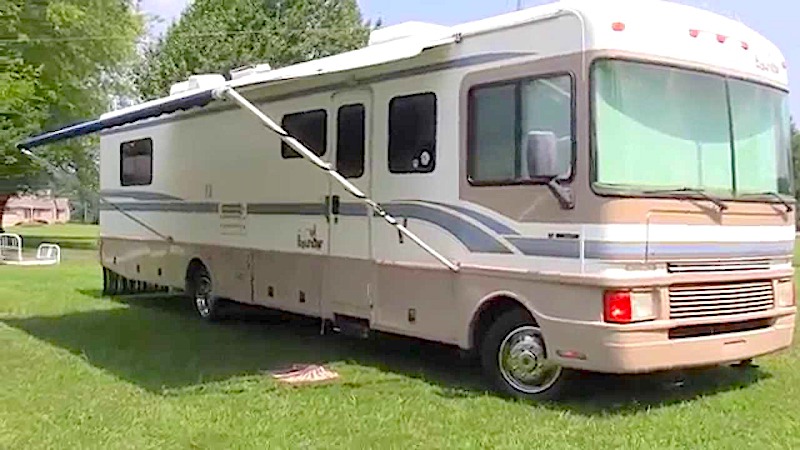
A fuzzy line can be drawn between the late 1980s and early 1990s to separate the classic and neo-classic Era. New technologies and designs show a clear difference between the two eras, but it didn’t happen overnight.
From a visual perspective, the Class A motorhome front-end reverted to the flat front from the pointed aerodynamic pointed shape. Flat and corrugated aluminum gave way to fiberglass paneling, giving RVs a lighter overall weight. Composite materials made sub-floors and cabinetry materials stronger while shaving down the dry weight.
From a societal standpoint, things cooled down for the industry for a while. As gas prices started to climb, consumers traded in their powerful V8 vehicles for fuel-efficient four and 6-cylinder cars and SUVs. The RV industry had to adapt. As the RV industry ramped back up with lightweight and fuel-efficient-friendly coaches, the most influential contributors were suppliers.
Ford’s F53 Dominates the Gas Chassis
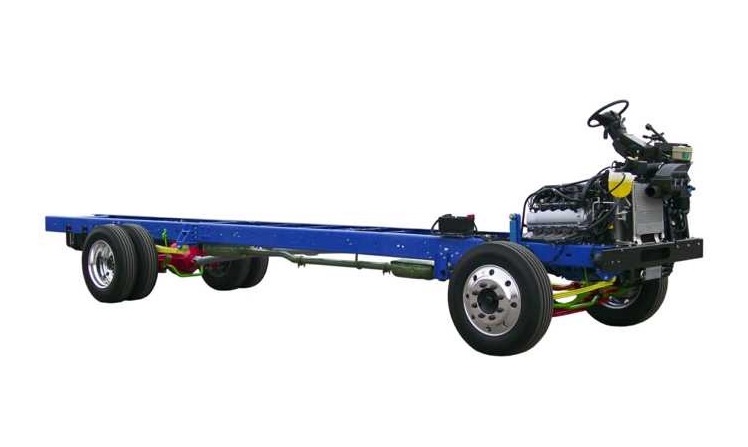
The Ford F-Series chassis began in the 1940s. Through the decades, it saw significant generation changes. In 1980, the sixth generation saw a medium-duty truck chassis that offered two different gas engines or three different diesel power plants. The early F-Series chassis would compete with the Chevrolet or Oldsmobile chassis, but ultimately win out as the motorhome foundation of choice.
The seventh-generation F-53 was the “nail in the coffin” for the other competitors. In 1998, Ford’s new generation chassis had the structure, length, and everything RV manufacturers wanted. It came paired with the new Triton Workhorse engine. The V10 pumped out over 300 horsepower and would climb from 420 to 457 lb./ft. Torque.
The chassis received a few minor alterations as technology advanced. The 6.4-liter engine stayed on the road until its V8 7.3 liter V8 next generation replaced it in 2021.
Chrysler Brings the True Face of Mercedes to America
Before the merger of Daimler Chrysler and Mercedes-Benz in May of 1998, the United States knew Mercedes as a luxury car brand. To the rest of the world, Mercedes was a vehicle manufacturer that built vehicles in all sectors.
To an American, the average person drives a Chevy; to the rest of the world, the average person drives a Mercedes.
Once the merger happened, Mercedes introduced Americans to their Sprinter van. The U.S. grew up with wide-bodied vans that you had to bend down to walk around in the cargo area. The Sprinter’s European-style had narrow sidewalls but a taller roof that allowed a person to stand more upright. The best part; it still had a wide enough wheelbase that was wide enough to handle tight turning and wind shear.
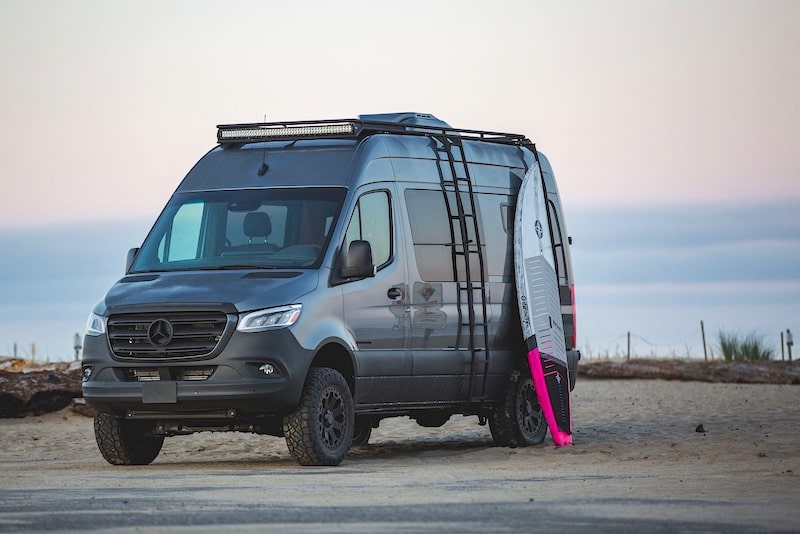
The American RV market was quite aware of European RV giants like Groupe Rapido and their Class B campervans built off of the Sprinter European-style chassis. Now that Americans were aware of and beginning to enjoy the chassis’ benefits, a flood of new Class B motorhomes began to hit the RV market.
Ford kept its E-Series chassis for the heavy-duty and Class C sectors but brought its European Transit van home to the U.S. Dodge introduced its Ram ProMaster to enter the revamped full-size van market. Existing and new independent RV companies jumped on these new chassis, making the Class B category one of the most popular types in this fuel-efficient demanding market.
Modern RV and Camper Era (2008 to Present)
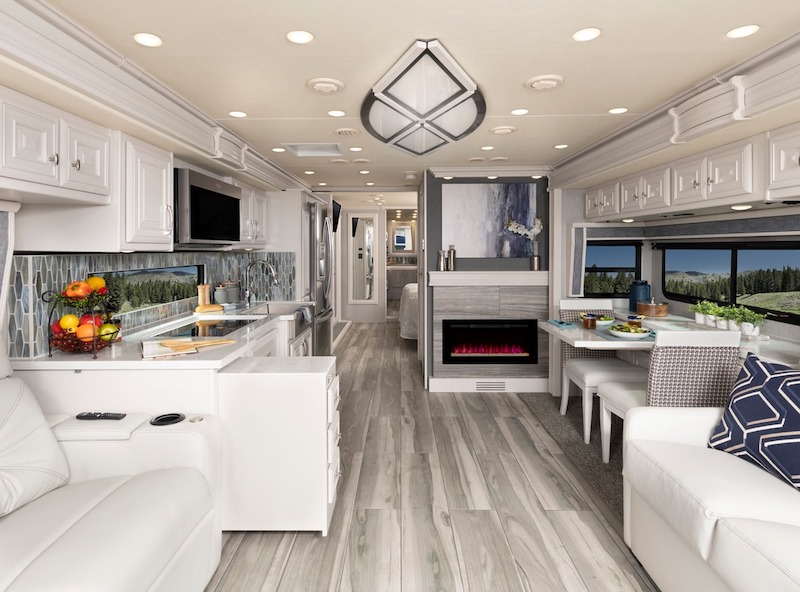
The 2008 financial crisis upended the RV industry. Legendary names that led the industry would close their doors for good. Others would merge for stability, and new companies opened up with innovations never seen before in the RV world.
The current era also saw changes in the consumer market. Millennials became the second-biggest consumer group in the industry. The need for low-cost coaches that supported their internet lifestyle became a requirement for RV manufacturers. Yet they couldn’t neglect the retiring Baby Boomers who had paradoxical demands in some respects.
Lightweight construction materials and new building techniques changed how RV manufacturing. New luxury levels, like residential refrigerators, granite countertops, fireplaces, and adjustable king-size beds, became a reality.
RVs further expanded into demographics like the disabled, work-on-the-road, and other groups. Off-road and extreme weather coaches became available to those who wanted to explore roads previously closed off. As technology progresses, who knows where RVs will take us.
RV Hall of Fame

The majority of RV manufacturers exist around Elkhart, Indiana. Among them is the RV Hall of Fame. This museum collects and preserves The Complete History of RVs, and Campers. It contains the history of everything in the RV world. You’ll see many of the coaches we’ve talked about and more. Some units in the collection are concept pieces or RVs from companies that had a short run.
The foundation started in 1972. Its purpose was to maintain the RVs’ history through the various publications, RV units, and other things related to the subject. In 1991, they opened the museum giving visitors a central location to discover the past. The current 100,000 square-foot building had its ribbon-cutting in 2007.
The greater Elkhart area is a great place to stay for an RV trip. After you enjoy the Hall of Fame and a few of the RV manufacturers’ plant tours, you can find many things to do in the area.

